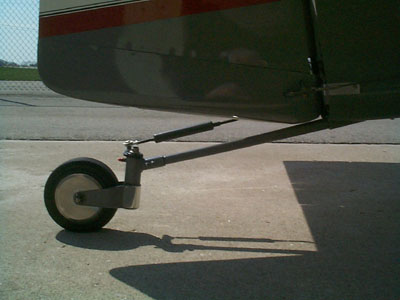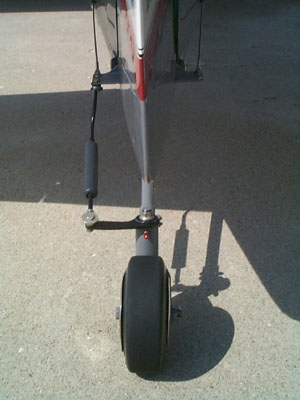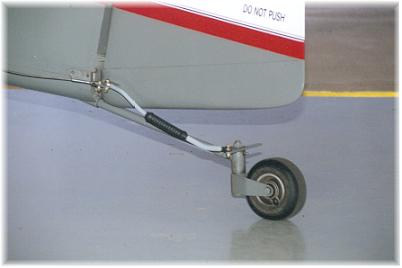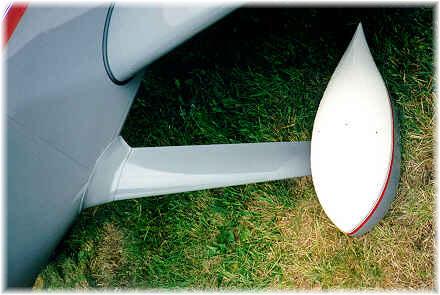 |
The tail wheel was replaced with a sealed bearing type after the first one wore out. The rubber is a little harder than the original one and I still haven't decided whether I like it or not. It rolls really nicely though and doesn't leave black marks on the painted hangar floor. Aluminum wheel covers dress up the wheel and reduce drag. The single steering link "looks" less draggy than the standard springs and gives good steering response. There is a small piece of leading edge tape on the fork to prevent stone chips. |
 |
Overhead view of the steering link. The first version I installed, pictured below, remained trouble free for 370 hours. More pictures and instructions on getting your very own steering link here. |
 |
|
| Homemade
landing lights. Indoor 12V halogens are very bright and have been turned
on for 700 hours. I used a 85W spot and a 50W flood hooked up to a
wigwag flasher. Very simple construction consisting of two aluminum plates sandwiching
the bulbs between them. The piano hinge allows for flexible locating and
easy removal by pulling the pins. The ceramic sockets are available at
Home Depot. Total cost for all materials was about $30 CDN.
Current loads are about 10 amps per set. I aimed the left side at the ground about 50' ahead for taxiing in the dark. The right side is aimed parallel with the chord line for "in flight" recognition. I fly out of a busy training airport with students from five schools learning to fly. It is very important for me to be highly visible. At night the tower sometimes gives other aircraft their position relative to the "guy with the lights". A friend who flies a Pitts for fun, and a 767 to afford the Pitts, refers to my system as "pussy lights". I think he's poking fun at me. My installation requires removal of the wing tips for servicing. Haven't needed to do that yet. |
|
|
The small size allows for minimum cutout in the D section. The forward mounting location gives good beam coverage. The lens is 1/16" Lexan that I formed in the kitchen oven. A thin bead of gray bathtub caulk around the edge makes it waterproof. The skin edge was ever so carefully rolled to form a tight fit to the lens. |
Pressure recovery wheel pants from Van's and Tracy Saylor gear leg fairings. The intersection fairings were hand build on a clay mold just like the plans suggest. Flying without any fairings and unpainted to this condition here added 15-17mph to the cruise speed. |
 |
 |